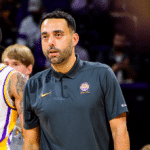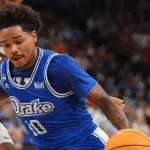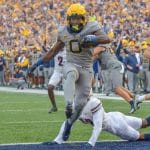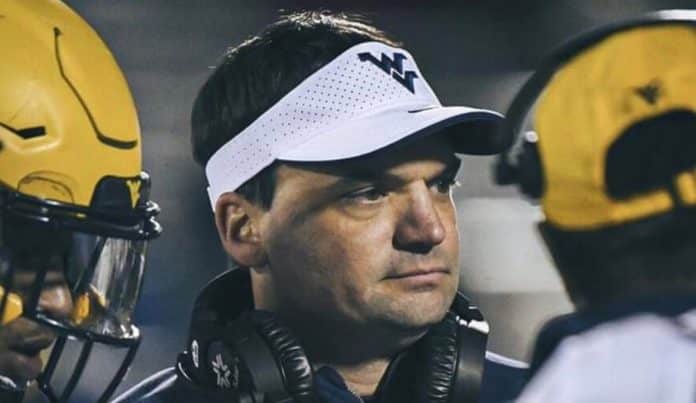
The Transfer Portal has changed college athletics. Student Athletes are now, more than ever, transferring away from the school they originally committed to. The reasons can vary from playing time and coaching changes, to personal hardships and moving closer to home, and a myriad of other reasons in between. Many college football fans look at the Transfer Portal in a bad light, and it is easy to see why. We grow attached to players, even if they are rotational players or young players that we have high hopes for. However, the Transfer Portal is a necessary evil for student athletes in a world where college coaches behave more as mercenaries than program leaders and athletic departments seem to give coaches a much shorter leash than ever before.
As West Virginia fans, the Transfer Portal seems like it has hit us the hardest. Its easy to understand why: 56 outgoing transfers to 19 incoming transfers since the Portal was started in 2019. Before the Portal, WVU was pulling in big time names that made significant impacts like Will Grier, Kenny Bigelow, Charles Sims, Clint Trickett, and Rushel Shell to name a few. And it makes sense. When players enter their name into a centralized database that every college coach in America has access to, the competition for a players commitment increases significantly.
This article is the first part in a series of articles that will outline and put into context the transfer issues WVU has experienced since the Portals establishment in 2019[1]. In Part 1, we are going to focus on just West Virginia. The goal is to understand the Mountaineers situations and issues before digging into how we compare to the larger group of FBS schools.
Note that the years in the charts below reflect the season year, not the calendar year. For example, 2019 covers from August 2018 to July 2019, and thus, 2021 reflects August 2020 through July 2021, and so on.
In January 2019, WVU named Neal Brown as its 35th head football coach, replacing Dana Holgorsen. After a new head coach is hired, it is common that a team will see a raise in player turnover. Players are recruited by specific coaches on a coaching staff, and it is rare for a position coach or coordinator to be retained by a new head coach. Good examples of this are Oklahoma this year (6 transfers in the past month), and Auburn when Bryan Harsin replaced the ousted Gus Malzhan (22 transfers).
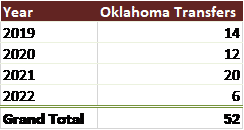
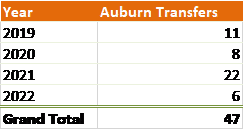
The strange thing about WVU is that there wasn’t a big spike after Neal Brown came on board. In fact, the year-by-year transfers were similar until this past season:
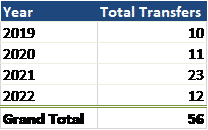
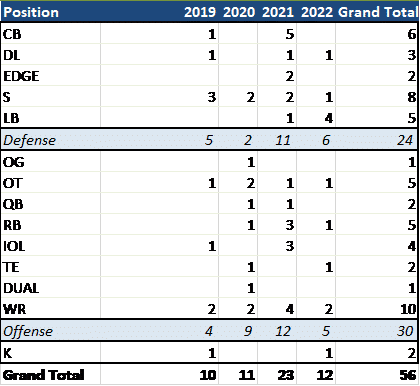
In 2018-2019, Dana Holgorsen left WVU for Houston and Neal Brown hired. Despite the head coaching change and the turnover of the entire assistant coaching staff, WVU only saw 5 transfers from defensive players and 4 from offensive players. The most noteworthy transfers were Derrek Pitts, a WV native who was starting at safety, and Kenny Robinson, who is listed as a transfer but actually had to go pro after academic issues. Some of this may be due to the large, 18 player senior class combined with a depleted roster due to Holgorsen’s preference for transfers and JUCO players. None the less, it was admirable that Neal Brown was able to stave off the typical player turnover that is associated with a wholesale coaching change.
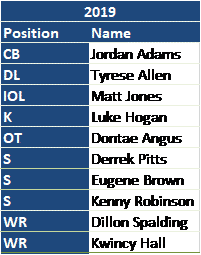
2019-2020 was encapsulated Neal Brown’s first season as WVU’s head coach. At the end of the season, Defensive Coordinator Vic Koenning resigned, which led to turnover from the defensive staff. Blake Seiler (inside linebackers) left to become Defensive Coordinator at Old Dominion, and Al Pogue (outside linebackers) left to become a defensive assistant at Auburn. To replace these departures, WVU hired Jeff Koonz (inside linebackers), Andrew Jackson (defensive assistant), Jeff Casteel (outside linebackers), and Dontae Wright (safeties). Additionally, Jordan Lesley and Jahmille Addae were promoted to Co-Defensive Coordinator. Finally, on the offensive side of the ball, Gerad Parker was added to the staff as Offensive Coordinator and receivers coach, replacing Xavier Dye in the latter. Despite the minimal offensive turnover, the offensive transfers increased by more than 100%, from 4 to 9. Many of these offensive transfers were due to increased competition or lack of playing time. Trey Lowe III left after it became apparent that he would not beat out Austin Kendall or Jarret Doege for playing time, and Martell Pettaway was buried on the depth chart behind Kennedy McCoy and Leddie Brown. However, some of the transfer decisions may have been driven by the coaching change as players who gave Neal Brown a chance didn’t mesh well with his style or philosophies. This includes players such as Josh Sill, JoVanni Stewart, and Tevin Bush, all of which saw considerable playing time before transferring. The 2019-2020 season was interesting as it showcased that Neal Brown is very personable and persuasive as he was able to initially hold off the transfer wave from his initial hiring. However, trickle of starters began to transfer a little less than a year into his tenure, and this may the cracks that started to form that led to the next two years.
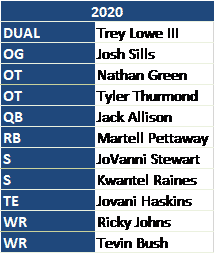
The 2020-2021 season was a pretty stable year for the coaching staff at large. At the end of the season, Jordan Lesley was promoted to full time defensive coordinator and Jahmille Addae left to become the defensive backs coach at Georgia. However, this seemingly minor move seemed to send shockwaves across the defense with 5 cornerbacks entering the transfer portal and 2 safeties along with 4 other players from the defense. The defensive was an interesting combination of starters and young players in this defensive pool of transfers. Dreshun Miller and Tykee Smith were full time starters with their starting role virtually locked in for the following season had they chosen to return. Young players like David Vincent-Okoli (CB, WVU’s highest rated recruit in the 2020 class), Quay Mays (DT, 3-star JUCO recruit), Tavian Mayo (CB, 3-star recruit in the 2019 class), and Tacorey Turner (CB, 3-star recruit in the 2019 class) left the program, most presumably because their main coach (Addae) was no longer with the program. However, despite the offense returning the same group of coaches, they saw the transfers grow even more, with 12 offensive players deciding to leave the program. The bulk of these transfers were from the offensive line (4 transfers – 3 Sophomores and 1 Junior) and wide receivers (4 transfers). It’s definitely a curious situation; during this year, there were many position battles across these two personnel groups, and in my opinion, there were no clear-cut winners heading into the 2021-2022 season. Now it is possible that coaches communicated where they fit on a projected depth chart, which led the players to transfer, but it is also possible that these players became disillusioned with their position coaches. I wonder about the later, especially with the lack of notable improvement we’ve seen on the offensive line over Matt Moore’s 3+ years here.
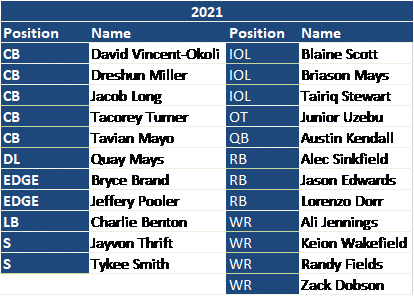
This leads us to this season, the 2021-2022 year. To start off, it is important to note that the NCAA did grant players a one time, ‘sit-out’ free year this past season, and it is likely that most schools will see an increase in players leaving the program. With that being said, the season has not ended yet and the team is already slotted to lose 12 players. Only 4 of these players were Juniors or Seniors, meaning that most of these players were recruited by Neal Brown and his staff. Some of these transfers make sense in context. Moorer (Sophomore) lost the starting right tackle job to true Freshman Wyatt Milum. Avarius Sparrow was 4th on the depth chart behind Sophomore Tony Mathis Jr. and true Freshman Justin Johnson Jr. Devell Washington was recruited as a WR, but moved to linebacker due to the need for depth at that position. However, the transfer of linebackers Eddie Watkins and James Thomas were strange, especially since WVU was playing safeties at linebacker late in the season. Kerry Martin may have been in the doghouse because of the Koenning situation, but WVU was playing corners at safety late in the season and Martin could have helped out there. Sam Brown may have been buried behind a group of experience WRs, but WVU found a way to get reps for Kaden Prather (and deservedly so) late in the year; was it not possible to do the same with Brown?
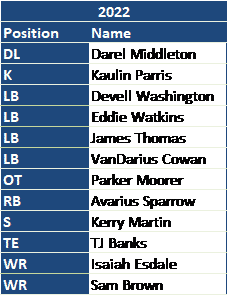
The past year and a half of transfers have been concerning. It seems like a leak started to form in the 2019-2020 season when starters began leaving the program. The staff may not have been concerned then, but leaks can quickly turn into a flood. Now, it seems like a flood is forming. WVU is not just losing players who couldn’t compete at a Power 5 level. In fact, WVU is losing more talent to P5 schools than they have to G5 schools in the past. The chart below shows a breakdown of what level of schools WVU transfers are transferring to (note that I excluded players where their destination is unknown or not listed currently on tools available online):
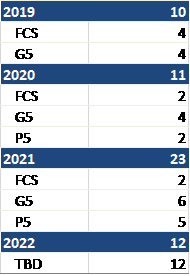
As displayed in this table, in 2019, only 40% of the players who left WVU even stayed in the FBS. In 2020, a little more than half (6 of 11) of transfers stayed in the FBS, but again, most of those transfers transferred down to a group of 5 school. However, this most recent batch of transfers does not look good for WVU. 5 players who transferred during the 2020-2021 period have landed at another Power 5 school, and 6 have transferred to a Group of 5 school. Only two have transferred out of the FBS altogether, which seems to be the one constant between 2019, 2020, and 2021. We have only heard where two transfers from the 2022 period are headed: Parker Moorer to ECU and VanDarius Cowan to Maryland. However, I would not be surprised to see Middleton, Martin, and Sam Brown end up at Power 5 schools, and that is just out of the 12 names that we know are transferring now. It is likely more names pop up after the bowl season and again during the spring.
It seems like a trend is forming where quality players are leaving the team. It is unknown what the cause of this could be. The coaching staff has been relatively stable over the past couple years. The team record over the past two seasons hasn’t been awful either (although we, as fans can agree it should probably be better). Additionally, we don’t have more than 2 or 3 irreplaceable, “star” guys on each side of the ball. So what is the reason we are seeing so many players transfer? Is it coaches, scheme fit, broken recruiting promises, conference uncertainty, location, NIL benefits, or opportunities elsewhere? It could be any and all of this. However, what is most important is that Neal Brown figures out a way to address the issue and figure out how to stop the bleeding.
Keep an eye out for the next part in this series in the coming days where we will cover how WVUs transfer stats over the years compare to other Power 5 conference teams.
Make sure to check out Brandon on The Voice of Motown Podcast. Subscribe and listen below:
[1] I pulled together info on every player that has transferred into or out of an FBS school from 2019 to date. The information outlined in this and all subsequent articles will be based off this information. Due to the time and effort I put into pulling this information together, I will not be sharing this information publicly. However, for any inquiries, questions, or information sharing requests, feel free to contact me.




